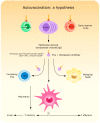Novel Insights in Anti-CD38 Therapy Based on CD38-Receptor Expression and Function: The Multiple Myeloma Model
- PMID: 33322499
- PMCID: PMC7764337
- DOI: 10.3390/cells9122666
Novel Insights in Anti-CD38 Therapy Based on CD38-Receptor Expression and Function: The Multiple Myeloma Model
Abstract
Multiple myeloma (MM) is a hematological disease characterized by the proliferation and accumulation of malignant plasmacells (PCs) in the bone marrow (BM). Despite widespread use of high-dose chemotherapy in combination with autologous stem cell transplantation (ASCT) and the introduction of novel agents (immunomodulatory drugs, IMiDs, and proteasome inhibitors, PIs), the prognosis of MM patients is still poor. CD38 is a multifunctional cell-surface glycoprotein with receptor and ectoenzymatic activities. The very high and homogeneous expression of CD38 on myeloma PCs makes it an attractive target for novel therapeutic strategies. Several anti-CD38 monoclonal antibodies have been, or are being, developed for the treatment of MM, including daratumumab and isatuximab. Here we provide an in-depth look atCD38 biology, the role of CD38 in MM progression and its complex interactions with the BM microenvironment, the importance of anti-CD38 monoclonal antibodies, and the main mechanisms of antibody resistance. We then review a number of multiparametric flow cytometry techniques exploiting CD38 antigen expression on PCs to diagnose and monitor the response to treatment in MM patients.
Keywords: CD38; CD38 antigen expression in various tissues; anti-CD38 monoclonal antibodies; bone marrow microenvironment; multiple myeloma; plasmacells.
Conflict of interest statement
The authors declare that the research was conducted in the absence of any commercial or financial relationships that could be construed as a potential conflict of interest.
Figures



References
-
- Engel P., Boumsell L., Balderas R., Bensussan A., Gattei V., Horejsi V., Jin B.Q., Malavasi F., Mortari F., Schwartz-Albiez R., et al. CD Nomenclature 2015: Human Leukocyte Differentiation Antigen Workshops as a Driving Force in Immunology. J. Immunol. 2015;195:4555–4563. doi: 10.4049/jimmunol.1502033. - DOI - PubMed
-
- Paiva B., Paino T., Sayagues J.M., Garayoa M., San-Segundo L., Martín M., Mota I., Sanchez M.L., Bárcena P., Aires-Mejia I., et al. Detailed characterization of multiple myeloma circulating tumor cells shows unique phenotypic, cytogenetic, functional, and circadian distribution profile. Blood. 2013;122:3591–3598. doi: 10.1182/blood-2013-06-510453. - DOI - PubMed
Publication types
MeSH terms
Substances
LinkOut - more resources
Full Text Sources
Medical
Research Materials

